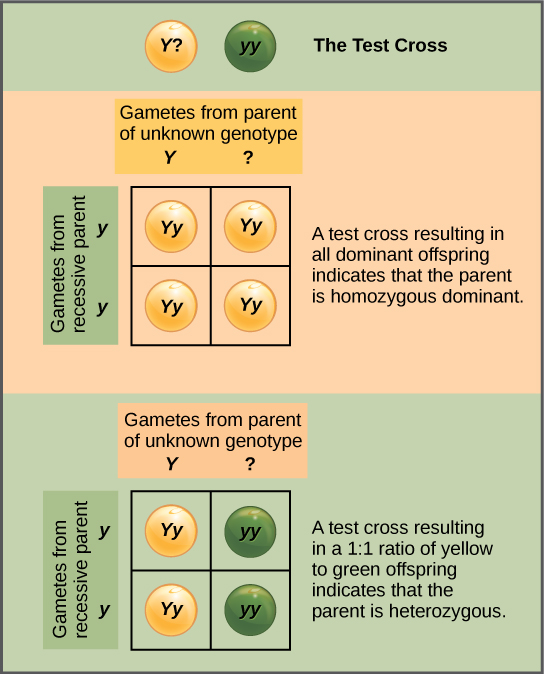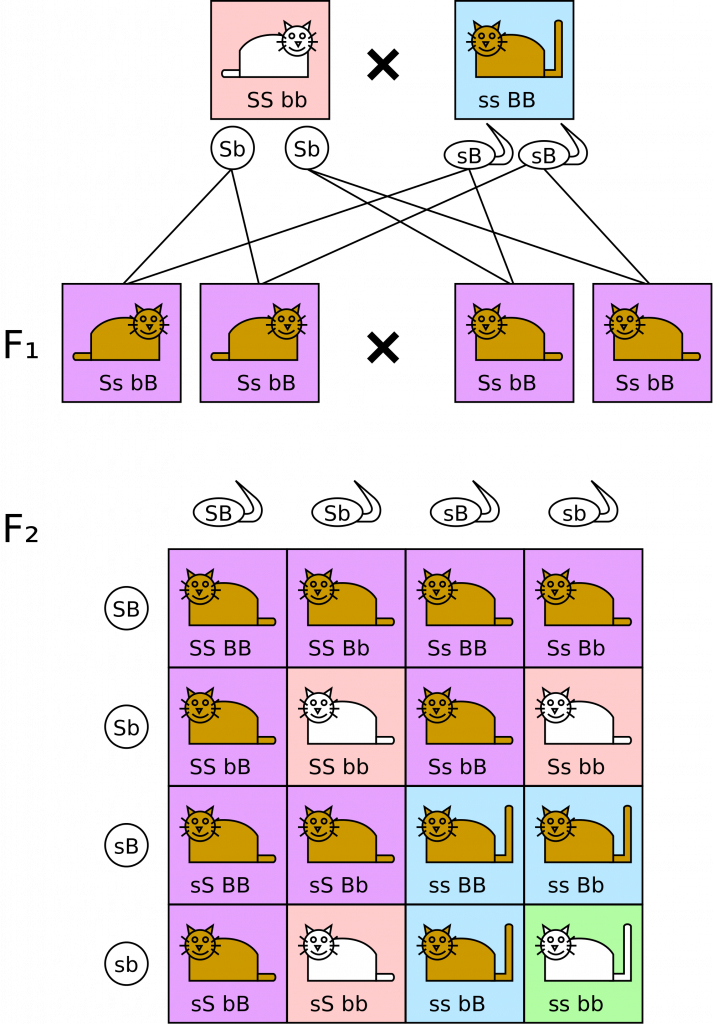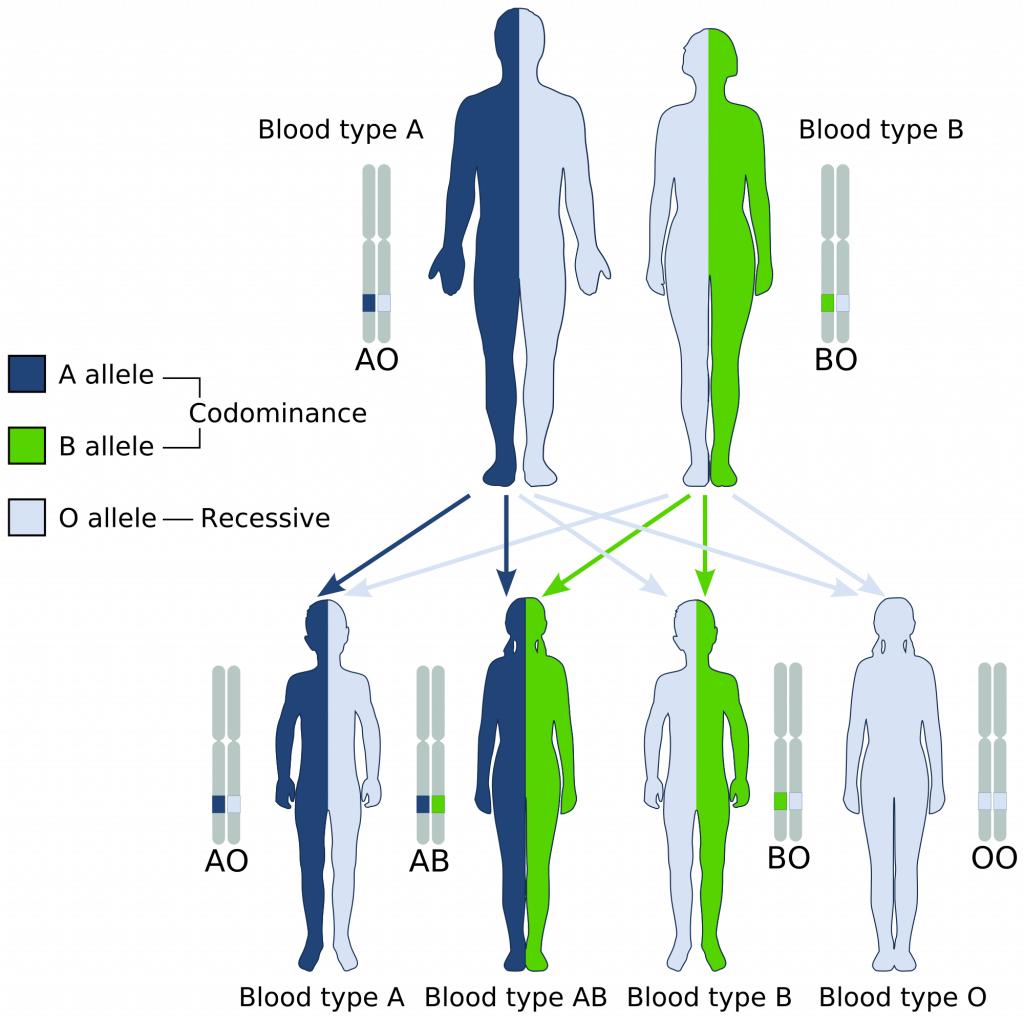Contents
Inheritance
Key Terms
- Genotype – The genetic constitution of an organism (the alleles it has for a gene).
- Phenotype – The expression of the genes and their interaction with the environment.
- Homozygous – A pair of homologous chromosomes carrying the same alleles for a single gene.
- Heterozygous – A pair of homologous chromosomes carrying two different alleles for a single gene.
- Recessive allele – An allele that is only expressed if no dominant allele is present.
- Dominant allele – An allele that will always be expressed in the phenotype.
- Codominant – Both alleles are equally dominant and expressed in the phenotype.
- Multiple Alleles – More than two alleles for a single gene.
- Sex-linkage – A gene whose locus is on the X chromosome.
- Autosomal Linkage – Genes that are located on the same chromosome (not the sex chromosomes).
- Epistasis – When one gene modifies or masks the expression of a different gene at a different locus.
- Monohybrid – Genetic inheritance cross of a characteristic determined by one gene.
- Dihybrid – Genetic inheritance cross for a characteristic determined by two genes.
Inheritance Crosses & Examples
Test Cross: A test cross can be used to determine whether an organism displaying a dominant characteristic is due to a homozygous dominant or heterozygous genotype. To determine the genotype, the organism in question is crossed with a member of its own species that is homozygous recessive for that trait. The offspring's phenotypes are then analyzed. If any of the offspring have the homozygous recessive trait, then the original parent in question must have been heterozygous for the dominant trait. 
Dihybrid: Below is an example of a genetic cross showing the inheritance of two genes at the same time. 
Codominance and Multiple Alleles: Blood group is an example of both codominance and multiple alleles. The phenotype for blood group can be A, B, AB, or O. These letters refer to which protein, or antigen, is found on the outside of red blood cells. Only one gene codes for this phenotype, but there are three alleles (multiple alleles). Allele IA codes for the A antigen and is dominant. Allele IB codes for the B antigen and is dominant. Allele IO codes for no antigen and is recessive. As allele IA and IB are both dominant, they will both be expressed to create the phenotype AB (a codominance example). 
Sex-Linkage Inheritance: The X chromosome is much larger than the Y chromosome; it contains a much larger non-homologous region that contains many non-sex-determining genes. For example, genes linked to hemophilia, Duchenne muscular dystrophy, and red-green color blindness.
Autosomal Linkage Inheritance: There are 23 pairs of chromosomes in humans on which there are many different genes. Autosomal linkage studies the inheritance of two genes located on the same chromosome, excluding the X and/or Y chromosome (the term autosomal refers to the non-sex-determining chromosomes). In this inheritance, assuming that crossing over did not occur to change the locus of the gene, the genes located on the same chromosomes cannot be separated during independent segregation and therefore have to be inherited together.
Epistasis: Coat color on Labrador retrievers is an example of epistasis. There are two genes that control coat color: one gene codes for whether pigment is produced or not, and the other gene codes for the concentration of the pigment. Gene 1 – Pigment produced (Allele E) OR Pigment not produced (e) Gene 2 – High pigment concentration- black (allele B) OR lower concentration -brown (Allele b) Gene 1 can mask the expression of gene 2 if the alleles inherited are e, coding for no pigment produced. Possible genotypes and phenotypes:
| Phenotype | Genotypes | Explanation |
| Yellow Labrador | eebb eeBB eeBb | Genotype for gene 1 is homozygous recessive, so gene 2 is masked because no pigment will be produced. |
| Chocolate Labrador | Eebb EEbb | Genotype for gene 1 codes for making pigment, so there must be at least one dominant E allele. The second gene must be homozygous recessive to code for brown. |
| Black Labrador | EeBb EEBb EeBB EEBB | Gene 1 codes for making pigment, so there must be at least one dominant E allele. For the Labrador to be black, the genotype for the second gene must contain at least one dominant B allele. |
The Hardy–Weinberg Principle: This is a mathematical model that can be used to predict the allele frequencies within a population. It assumes that there will be no change in the allele frequency between generations within a population (e.g., no deaths, births, or migration), so it is not perfectly accurate. The frequency of alleles, genotypes, and phenotypes in a population can be calculated using the Hardy–Weinberg equation: p2 + 2pq + q2 = 1. This equation needs to be used simultaneously with the following equation to help work out p or q first to then use the above equation. p + q = 1. Where: p = the frequency of one (usually the dominant) allele, q = the frequency of the other (usually recessive) allele of the gene, p2 = The frequency of the homozygous dominant genotype, 2pq = The frequency of the heterozygous genotype, q2 = The frequency of the homozygous recessive genotype.
Chi-Squared Statistic in Inheritance: All the above types of genetic inheritance can be used to determine an estimate of the expected frequency of each phenotype/genotype with certain parents. Chi-squared can be used to determine whether the frequency or ratio of phenotypes you expected is significantly different from the ratio you observe.

